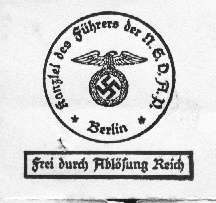Hitler's Chancellery

Hitler's Chancellery, known as the Kanzlei des Führers der NSDAP ("Chancellery of the Führer of the Nazi Party" or KdF) was a Nazi Party organization. Also known as the Privatkanzlei des Führers, the agency served as private chancellery of Adolf Hitler, handling many different issues pertaining to matters such as complaints against party officials, appeals from party courts, official judgments, clemency petitions by NSDAP fellows and Hitler's personal affairs.
Organization
The Chancellery established in 1934 in Berlin as a separate agency which was parallel to the German Reich Chancellery under Hans Heinrich Lammers and the Nazi Party Chancellery (until 1941: "Staff of the Deputy Führer") in Munich, led by Martin Bormann.[1] The Kanzlei des Führers was headed by SS-Obergruppenführer Philipp Bouhler bearing the title of Der Chef der Kanzlei des Führers der NSDAP.[2] As chief of the KdF, Bouhler also held the rank of a Nazi Reichsleiter. He was appointed as chief on 17 November 1934 and held that position until 23 April 1945;[3] though largely disempowered from 1942 onwards in favour of Bormann. In 1939 the KdF moved its seat to the New Reich Chancellery building on Voßstraße No. 4.

The following five main offices (Hauptämter) composed the Kanzlei des Führers subordinate directly to Hitler:
- Hauptamt I: Privatkanzlei (Personal Affairs of the Führer); chief: Albert Bormann[4]
- Hauptamt II: Angelegenheiten betr. Staat und Partei (Affairs of the Party, State, and the Armed Forces); chief: Viktor Brack
- Hauptamt III: Gnadenamt für Parteiangelegenheiten (Appeals directly to Hitler); chief: Hubert Berkenkamp; later from 1941 forward: Kurt Giese
- Hauptamt IV: Sozial- und Wirtschaftsangelegenheiten (Affairs of economic and social questions); chief: Heinrich Cnyrim
- Hauptamt V: Internes und Personal (Personal and Employment affairs of various offices); chief: Herbert Jaensch.
Action T4
Hauptamt II officials under Viktor Brack played a vital role in organizing the killing of physically or mentally handicapped people in the Action T4 "euthanasia" programme, especially the child "euthanasia" from 1939. By decree of 1 September, Hitler appointed Bouhler and his personal physician Karl Brandt "euthanasia" commissioners.[5] To execute the deportations, the Gemeinnützige Krankentransport GmbH camouflage organization was established, residing on Tiergartenstraße No. 4. Many employees later joined the Operation Reinhard killings executed under Odilo Globocnik in the Polish General Gouvernement.
Notes
- ↑ McNab 2009, pp. 78-80.
- ↑ Hamilton 1984, p. 251.
- ↑ Miller 2006, p. 157.
- ↑ Hamilton 1984, pp. 135, 136.
- ↑ Facsimile
References
- Hamilton, Charles (1984). Leaders & Personalities of the Third Reich, Vol. 1. R. James Bender Publishing. ISBN 0-912138-27-0.
- McNab, Chris (2009). The Third Reich. Amber Books Ltd. ISBN 978-1-906626-51-8.
- Miller, Michael (2006). Leaders of the SS and German Police, Vol. 1. R. James Bender Publishing. ISBN 978-9-3297-0037-2.